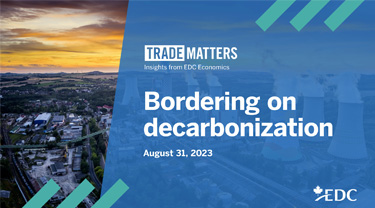The policy reduces the competitive advantage of exporters from non-carbon-pricing countries and for those less focused on emissions reduction. Exporters from stringent carbon price jurisdictions, or those engaged in mitigation efforts, will benefit from a levelling of the playing field when exporting to the EU. This has the potential to drastically alter trade flows to the region.
Beyond reshuffling exporter advantages, the policy will also introduce new challenges and costs related to reporting and verification. Low-carbon intensive producers will now need to track and verify their emissions to be given credit for their greener production processes. These added requirements could be burdensome for smaller producers and will increase production costs.
So, what does this mean for Canadian exporters? Canada’s relatively advanced carbon pricing system will offer substantial reductions in EU import fees. Many of our largest competitors in the European market (such as Russia, China, and the United States) don’t have carbon pricing systems and would face additional fees under the new policy.
Canada’s renewable energy electricity grid, which offers extensive opportunities to further decarbonize production processes, could provide an additional boost to our competitive advantage. Overall, the implementation of the EU policy offers significant opportunities for Canadian exporters in key industries if companies are prepared. Luckily, there’s still time before enforcement.
Some major risks for Canadian exporters include:
- new costs for obtaining policy compliance,
- time invested in assessing organizational opportunities, and;
- investments in scaling up capacity to meet new demands.
After Canadian companies build their carbon reporting capabilities, and potentially bolster productive capacities, they may still have trouble connecting with the EU importers, who must now re-evaluate their suppliers.
The bottom line?
The EU’s carbon border policy introduces more uncertainty and challenges for global suppliers, but Canadian exporters are uniquely positioned to capitalize on these developments. With less than three years until fees are phased in, forward planning and action is key to leveraging our ability to meet the evolving demands of the European market.
To learn more about this topic, check out our detailed report.
This week, a very special thanks to William Thomas, research assistant in EDC’s Research & Analysis Department.
As always, at EDC Economics, we value your feedback. If you have ideas for topics that you would like us to explore, please email us at economics@edc.ca and we’ll do our best to cover them.






